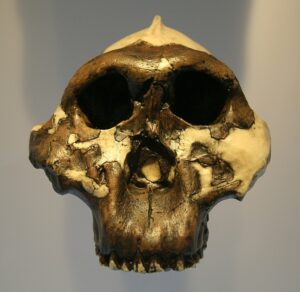Once again, this article goes beyond the realm of prehistory. Although… the Cenozoic is the most recent geological era in which we are currently living, and it also includes prehistory! The Cenozoic is the era during which the Earth evolved into the one we know today.
Early Cenozoic
The Cenozoic era began with an extremely famous event: the extinction of the dinosaurs. Also known as the “K/T extinction” or “Cretaceous/Tertiary extinction”, this mass extinction took place 66 million years ago (later abbreviated to Ma). In fact, dinosaurs are not the only living creatures to disappear. Over 60% of the world’s flora and fauna are becoming extinct. Mammals appeared shortly before 200 Ma, during the era preceding the Cenozoic, and were small animals at the time. The massive disappearance of large aquatic and terrestrial animals such as dinosaurs has enabled mammals to flourish, freeing up new ecological niches. Why is this important? Keep in mind that without mammals, there are no primates, and without primates … noHomo sapiens, our species!
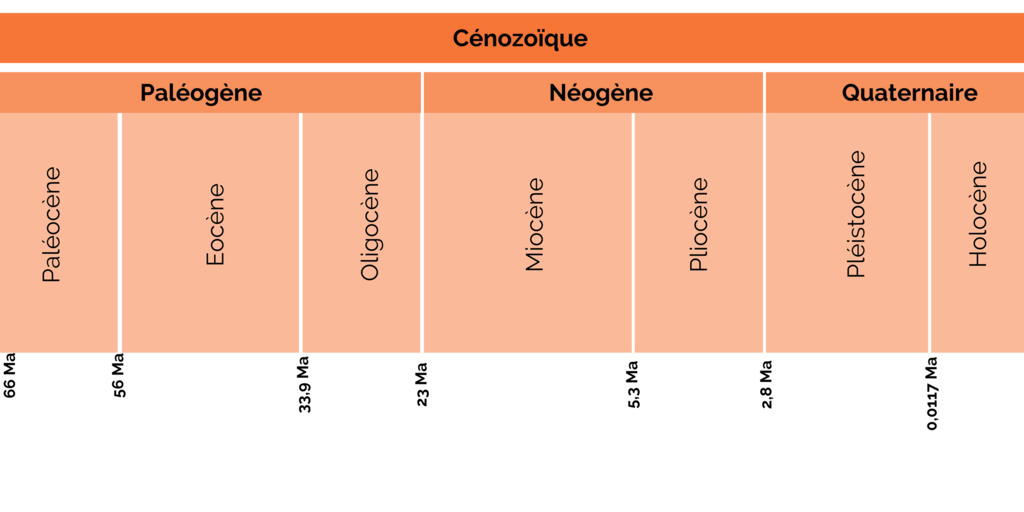
What happens during this period?
In general, the Cenozoic was marked by intense tectonic activity and intensified orogenesis, particularly in the Alps and Pyrenees. These gave rise to today’s mountain ranges. Continental drift has also led to their current position. Climatic instability sets in throughout the Cenozoic, resulting in the alternation of glacial and interglacial periods.
Around 65 million years ago
The continents are still relatively well centered on the equator and divided between the northern and southern hemispheres. This creates a large equatorial ocean current, homogenizing ocean temperatures towards the warm side. As a result, tropical and subtropical regions account for the majority of our planet’s population. Many land bridges exist at this time, helping mammals to disperse around the globe. One example is the area linking North America and the Eurasian continent, known as “Beringia”.
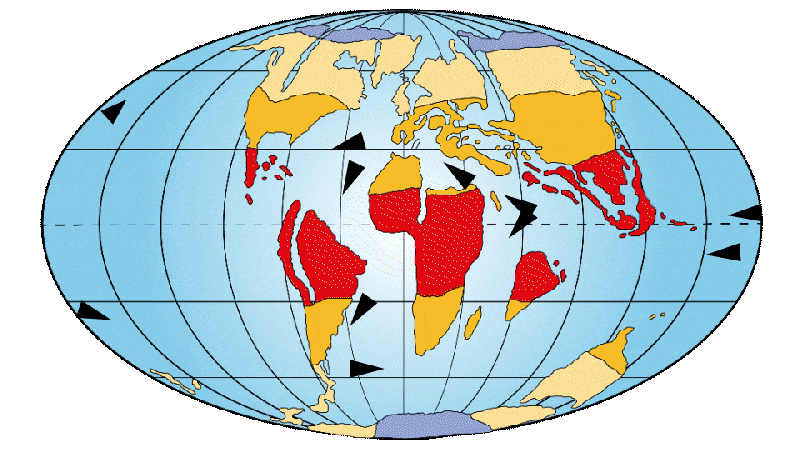
Between 56 and 34 million years ago
The continents move slightly. India moves closer to Asia and Australia takes off from Antarctica. This changes the way ocean currents are distributed around the globe. It was at this time that the so-called “Lower Eocene climatic optimum” occurred, corresponding to the warmest period of this age. Tropical zones then rise to much higher latitudes. It was at this time, around 56 Ma, that the first primates appeared.

Around 40 million years ago
Drake Strait, the arm of the sea between South America and Antarctica, is beginning to open up. This opening brings 2 oceans into contact, increasing the formation of diatoms and resulting in atmospheric change. Diatoms are photosynthetic microorganisms. This means they capture carbon dioxide (CO2) and release oxygen (O2) into the atmosphere, thereby reducing the amount ofCO2 in the atmosphere. The greenhouse effect is then less powerful and temperatures fall. This marked the beginning of a period of climatic destabilization and cooling. This major climate change resulted in a mass extinction of the first primates, dubbed the “Great Divide”. Nevertheless, one group of primates survived, the simiiformes, better known as “monkeys”, to which we Homo sapiens belong. Tropical forests are now confined to the equator, while temperate forests are spreading. This leads to new distributions of flora and fauna.
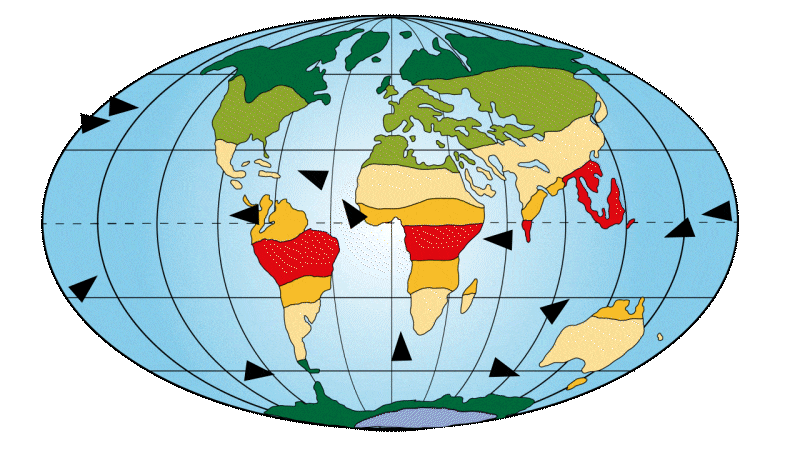
From 23 million years ago
The layout of the continents began to resemble what we know today. A large marine current, known as the circumpolar current, is finally being set up around Antarctica. This causes the oceans to shift from a warm to a cold regime. This change in currents led to the appearance of the first polar caps at the north and south poles. A greater fragmentation and diversification of climatic zones is taking place, similar to what exists today.
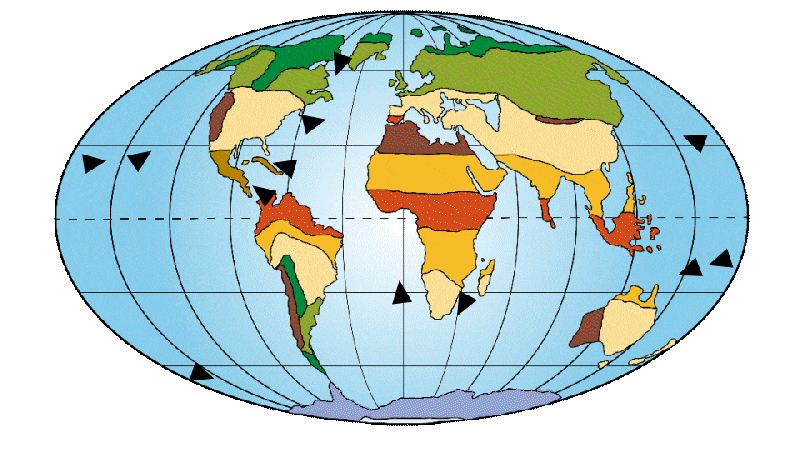
Setting up the Rift Valley
One last highlight before we wrap up! Around 10 Ma, the Rift Valley began to take shape. This corresponds to an almost 6,000 km-long fissure running from the Red Sea to the south of the African continent. The Rift Valley is thought to have played an important role in the emergence of the first Hominins, but we’ll tell you more about that another time!
We stop at the gateway to prehistory. This article is far from exhaustive on the Cenozoic, but our aim is to help you understand that the history of the Earth and life are intimately linked. Climatic, atmospheric and geological upheavals have a major influence on the distribution of plant and animal species, as well as on their extinction and appearance. So, like any other animal species, the emergence of hominins depends on the environment.
Feel free to ask us questions and give us feedback on the blog. You can also contact us by e-mail. You can also follow us on Instagram, Facebook, Twitter, LinkedIn, Youtube and TikTok!
See you soon,
The Prehistory Travel team.
Bibliography :
- [1] Costeur L., Maridet O., Merceron G. (2018) -Les mammifères cénozoïques: Diversifications, adaptations et environnements, ISTE Group, 287 p.
- [2] Friis E.M., Crane P.R., Pedersen K.R. (2011) – Early Flowers and Angiosperm Evolution, Cambridge University Press, 597 p.
- [3] Huyghe D. (s. d.) – Changements climatiques globaux et forçage tectonique au Paléogène. Exemples du Bassin de Paris et des Pyrénées, , p. 359.
- [4] Lagabrielle yves, Godderis yves, Donnadieu yannick, Malavieille J., Suarez M. (2009) – The tectonic history of Drake Passage and its possible impacts on global climate, Earth and Planetary Science Letters, 279, 3-4, p. 197-211.

